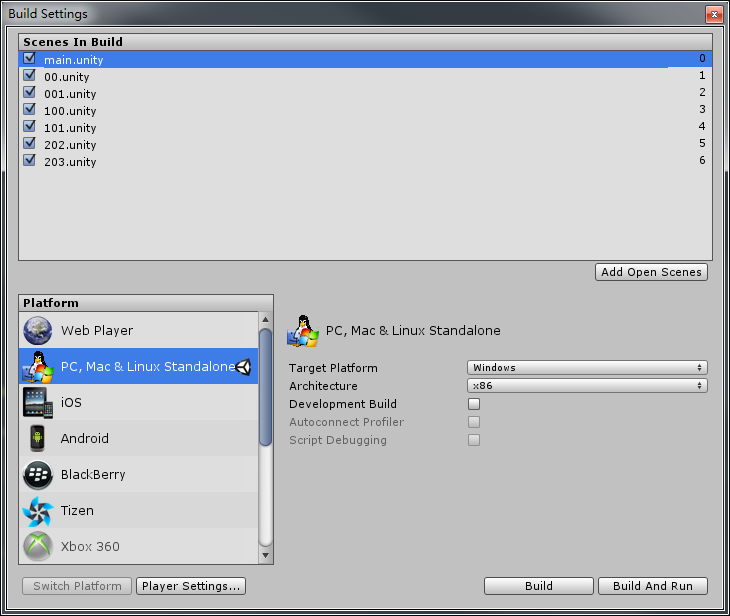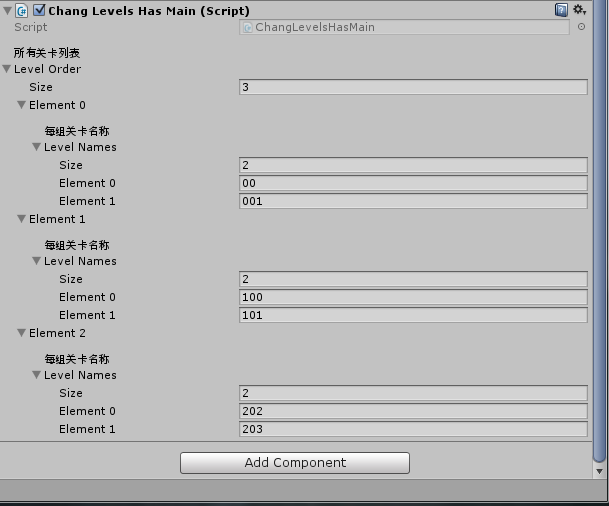UGUI_游戏菜单场景切换
事件委托
GameManger(空物体)+GameManger脚本——重要的方式
public class GameManger : MonoBehaviour {
public void OnStartGame(string sceneName)
{
Application.LoadLevel(sceneName);
}
}
using System.Collections;
using System.Collections.Generic;
using UnityEngine;
using UnityEngine.SceneManagement; public class GameManger : MonoBehaviour
{
public void OnStartGame(int sceneIndex)
{
//Application.LoadLevel(sceneIndex);
SceneManager.LoadScene();
}
}
Unity3D SceneManager场景管理用法总结
一、Unity关卡
Unity 使用过程中关卡加载和卸载是大多数三维引擎都要提供的基本功能。
因为关卡切换在游戏中非常常用。
在之前的版本中Unity的关卡切换使用的是:
Application.loadedLevel();- 1看看Application类,此时这个类的功能比较繁杂,比较多。只看与关卡相关的:
[Obsolete("Use SceneManager.LoadScene")]
public static void LoadLevel(string name);
[Obsolete("Use SceneManager.LoadScene")]
public static void LoadLevel(int index);
[Obsolete("Use SceneManager.LoadScene")]
public static void LoadLevelAdditive(string name);
[Obsolete("Use SceneManager.LoadScene")]
public static void LoadLevelAdditive(int index);
//
// 摘要:
// ///
// Unloads all GameObject associated with the given scene. Note that assets are
// currently not unloaded, in order to free up asset memory call Resources.UnloadAllUnusedAssets.
// ///
//
// 参数:
// index:
// Index of the scene in the PlayerSettings to unload.
//
// scenePath:
// Name of the scene to Unload.
//
// 返回结果:
// ///
// Return true if the scene is unloaded.
// ///
[Obsolete("Use SceneManager.UnloadScene")]
public static bool UnloadLevel(string scenePath);
//
// 摘要:
// ///
// Unloads all GameObject associated with the given scene. Note that assets are
// currently not unloaded, in order to free up asset memory call Resources.UnloadAllUnusedAssets.
// ///
//
// 参数:
// index:
// Index of the scene in the PlayerSettings to unload.
//
// scenePath:
// Name of the scene to Unload.
//
// 返回结果:
// ///
// Return true if the scene is unloaded.
// ///
[Obsolete("Use SceneManager.UnloadScene")]
public static bool UnloadLevel(int index);
注解:
这是之前的Application中的关卡的加载和卸载。
当然现在在新版本(Unity5.3以上)中,有了新的变化,那就是SceneManager类了处理。
二、Untiy的SceneManager类
自从Unity5.3版本,Unity 的关卡切换就添加了新的SceneManager的类来处理。
当然要安装过了Unity文档帮助,并且给下面路径一样,就可以知道在本地打开。
本地链接:
file:///C:/Program%20Files/Unity5.3.0/Editor/Data/Documentation/en/Manual/UpgradeGuide53.html
也可以在Unity中搜索SceneManager来查看。
#region 程序集 UnityEngine, Version=0.0.0.0, Culture=neutral, PublicKeyToken=null
// H:\Unity\UnityProject\ShiftLevels\Library\UnityAssemblies\UnityEngine.dll
#endregion using UnityEngine.Internal; namespace UnityEngine.SceneManagement
{
//
// 摘要:
// ///
// Scene management at run-time.
// ///
public class SceneManager
{
public SceneManager(); public static int sceneCount { get; }
// public static int sceneCountInBuildSettings { get; } public static Scene GetActiveScene(); public static Scene[] GetAllScenes();
// 参数:
// index:
// Index of the scene to get. Index must be greater than or equal to 0 and less
// than SceneManager.sceneCount.
public static Scene GetSceneAt(int index); // 返回结果:
// ///
// The scene if found or an invalid scene if not.
// ///
public static Scene GetSceneByName(string name); // Searches all scenes added to the SceneManager for a scene that has the given
// asset path.
// ///
//
// 参数:
// scenePath:
// Path of the scene. Should be relative to the project folder. Like: "AssetsMyScenesMyScene.unity".
public static Scene GetSceneByPath(string scenePath);
[ExcludeFromDocs]
public static void LoadScene(int sceneBuildIndex);
[ExcludeFromDocs]
public static void LoadScene(string sceneName); // 参数:
// sceneName:
// Name of the scene to load.
//
// sceneBuildIndex:
// Index of the scene in the Build Settings to load.
//
// mode:
// Allows you to specify whether or not to load the scene additively. See SceneManagement.LoadSceneMode
// for more information about the options.
public static void LoadScene(int sceneBuildIndex, [DefaultValue("LoadSceneMode.Single")] LoadSceneMode mode); // 参数:
// sceneName:
// Name of the scene to load.
//
// sceneBuildIndex:
// Index of the scene in the Build Settings to load.
//
// mode:
// Allows you to specify whether or not to load the scene additively. See SceneManagement.LoadSceneMode
// for more information about the options.
public static void LoadScene(string sceneName, [DefaultValue("LoadSceneMode.Single")] LoadSceneMode mode);
[ExcludeFromDocs]
public static AsyncOperation LoadSceneAsync(int sceneBuildIndex);
[ExcludeFromDocs]
public static AsyncOperation LoadSceneAsync(string sceneName); // 参数:
// sceneName:
// Name of the scene to load.
//
// sceneBuildIndex:
// Index of the scene in the Build Settings to load.
//
// mode:
// If LoadSceneMode.Single then all current scenes will be unloaded before loading.
public static AsyncOperation LoadSceneAsync(int sceneBuildIndex, [DefaultValue("LoadSceneMode.Single")] LoadSceneMode mode); // 参数:
// sceneName:
// Name of the scene to load.
//
// sceneBuildIndex:
// Index of the scene in the Build Settings to load.
//
// mode:
// If LoadSceneMode.Single then all current scenes will be unloaded before loading.
public static AsyncOperation LoadSceneAsync(string sceneName, [DefaultValue("LoadSceneMode.Single")] LoadSceneMode mode);
// // 参数:
// sourceScene:
// The scene that will be merged into the destination scene.
//
// destinationScene:
// Existing scene to merge the source scene into.
public static void MergeScenes(Scene sourceScene, Scene destinationScene);
//
// 摘要:
// ///
// Move a GameObject from its current scene to a new scene. /// It is required that
// the GameObject is at the root of its current scene.
// ///
//
// 参数:
// go:
// GameObject to move.
//
// scene:
// Scene to move into.
public static void MoveGameObjectToScene(GameObject go, Scene scene);
// // 返回结果:
// ///
// Returns false if the scene is not loaded yet.
// ///
public static bool SetActiveScene(Scene scene); // ///
public static bool UnloadScene(string sceneName);
//
// 摘要:
// ///
// Unloads all GameObjects associated with the given scene. Note that assets are
// currently not unloaded, in order to free up asset memory call Resources.UnloadAllUnusedAssets.
// ///
//
// 参数:
// sceneBuildIndex:
// Index of the scene in the Build Settings to unload.
//
// sceneName:
// Name of the scene to unload.
//
// 返回结果:
// ///
// Returns true if the scene is unloaded.
// ///
public static bool UnloadScene(int sceneBuildIndex);
}
}
三、SceneManager对于获取场景的一些操作
(一)
SceneManager
class in UnityEngine.SceneManagement
描述:运行时的场景管理。
静态变量sceneCount: 当前加载的场景的总数。
前加载的场景的数量将被返回。
sceneCountInBuildSettings : 在BuildSettings的号码。
(二)
CreateScene:在运行时创建一个空的新场景,使用给定的名称。
在运行时创建一个空的新场景,使用给定的名称。
新的场景将开放相加到层次与现有已经打开的场景。新场景的路径将是空的。此函数用于在运行时创建场景。创建一个场景编辑时间(例如,使编辑脚本或工具需要创建场景时),使用editorscenemanager.newscene。
(三)
public static SceneManagement.Scene GetActiveScene()
现场的活动场景。
描述:获取当前活动场景。
当前活动的场景将被用来作为目标由脚本实例化新的游戏对象现场。
using UnityEngine;
using UnityEngine.SceneManagement; public class GetActiveSceneExample : MonoBehaviour
{
void Start()
{
Scene scene = SceneManager.GetActiveScene(); Debug.Log("Active scene is '" + scene.name + "'.");
}
}
(四)
public static SceneManagement.Scene GetSceneAt(int index);
index:场景索引。指数必须大于或等于0和小于scenemanager.scenecount。
返回:
根据给定的参数返回一个场景引用。
获取现场在添加场景的场景管理器的列表索引:
using UnityEditor;
using UnityEditor.SceneManagement;
using UnityEngine.SceneManagement;
using UnityEngine;
public class Example
{
// adds a menu item which gives a brief summary of currently open scenes
[MenuItem("SceneExample/Scene Summary")]
public static void ListSceneNames()
{
string output = "";
if (SceneManager.sceneCount > )
{
for (int n = ; n < SceneManager.sceneCount; ++n)
{
Scene scene = SceneManager.GetSceneAt(n);
output += scene.name;
output += scene.isLoaded ? " (Loaded, " : " (Not Loaded, ";
output += scene.isDirty ? "Dirty, " : "Clean, ";
output += scene.buildIndex >= ? " in build)\n" : " NOT in build)\n";
}
}
else
{
output = "No open scenes.";
}
EditorUtility.DisplayDialog("Scene Summary",output, "Ok");
}
}
(五)
public static SceneManagement.Scene GetActiveScene();
获取当前活动场景。
当前活动的场景将被用来作为目标由脚本实例化新对象。
using UnityEngine;
using UnityEngine.SceneManagement; public class GetActiveSceneExample : MonoBehaviour
{
void Start()
{
Scene scene = SceneManager.GetActiveScene(); Debug.Log("Active scene is '" + scene.name + "'.");
}
} public static void LoadScene(int sceneBuildIndex, SceneManagement.LoadSceneMode mode = LoadSceneMode.Single);
public static void LoadScene(string sceneName, SceneManagement.LoadSceneMode mode = LoadSceneMode.Single);
sceneName: 需发加载的场景名称或路径。
sceneBuildIndex:在“ Build Settings”加载中的场景的索引。
Mode:允许您指定是否要加载相加现场。见LoadScene模式有关选项的详细信息。
LoadSceneMode:在播放器加载一个场景时使用。
Single:关闭所有当前场景和加载一个新场景。
Additive:将场景添加到当前加载的场景中。
你可以使用这个异步版本:LoadSceneAsync。
using UnityEngine;
using UnityEngine.SceneManagement; public class ExampleClass : MonoBehaviour {
void Start () {
// Only specifying the sceneName or sceneBuildIndex will load the scene with the Single mode
SceneManager.LoadScene ("OtherSceneName", LoadSceneMode.Additive);
}
}
四、5.3的实现代码
上代码:
/**************************************************************************
Copyright:@maxdong
Author: maxdong
Date: 2017-07-04
Description:加载关卡,可以分组加载和卸载。使用Unity版本为5.3.0.
因为里面使用了场景管理的一个类,这个类在5.3.0以上版本才添加的。
测试操作:使用空格键来切换场景,然后间隔5秒后才开始卸载。
**************************************************************************/
using UnityEngine;
using System.Collections;
using UnityEngine.SceneManagement; [System.Serializable]
public class LevelOrder
{ [Header("每组关卡名称")]
public string[] LevelNames;
} public class ChangLevelsHasMain : MonoBehaviour
{
[Header("所有关卡列表")]
public LevelOrder[] levelOrder;
private static int index;
private int totalLevels = ;
private int levelOrderLength; void Start ()
{
for (int i = ; i < levelOrder.Length; i++)
{
totalLevels += levelOrder[i].LevelNames.Length;
} if (totalLevels != SceneManager.sceneCountInBuildSettings)
{ }
levelOrderLength = levelOrder.Length;
} // Update is called once per frame
void Update ()
{
if (Input.GetKeyDown(KeyCode.Space))
{
bool isOk = LoadNextLevels();
if (isOk)
{
InvokeRepeating("UnloadLastLevel", 2.0f, );
}
}
} bool LoadNextLevels()
{
bool bResult = true;
//index = index % levelOrderLength;
if (index < || index >= levelOrderLength)
{
bResult = false;
return bResult;
} int LoadTimes = levelOrder[index].LevelNames.Length;
for (int i = ; i < LoadTimes; i++)
{
SceneManager.LoadSceneAsync(levelOrder[index].LevelNames[i], LoadSceneMode.Additive);
}
return bResult;
} void UnloadLastLevel()
{
if (index == )
{
index++;
CancelInvoke("UnloadLastLevel");
return;
}
// 上一組的關卡
int TmpLast = (index - ) >= ? (index - ) : levelOrderLength - ;
int LoadTimes = levelOrder[index].LevelNames.Length;
for (int i = ; i < LoadTimes; i++)
{
Scene Tmp = SceneManager.GetSceneByName(levelOrder[index].LevelNames[i]);
if (!Tmp.isLoaded)
{
return;
}
} // 下一關卡全部加載完畢後,卸載之前關卡
for (int i = ; i < levelOrder[TmpLast].LevelNames.Length; i++)
{
SceneManager.UnloadScene(levelOrder[TmpLast].LevelNames[i]);
}
index++;
CancelInvoke("UnloadLastLevel");
}
}
就这样就可以了。
代码主要是按组来加载关卡,然后按组来卸载。
测试中,按下空格键来加载,每组关卡在一定时间后,(这里设置的5秒)自动卸载前一组关卡。这里主地图是不卸载的,会一直存在的。
怎么设置的呢?首先需要在Build setting中中把所有要处理的关卡放进来。要不就会在加载过程中报错。
如下图:
然后把代码挂在主地图的任意对象对象上就可以了.
UGUI_游戏菜单场景切换的更多相关文章
- cocos2dx3.1从零学习(二)菜单、场景切换、场景传值
转:http://www.it165.net/pro/html/201406/16195.html 回顾一下上一篇的内容,我们已经学会了创建一个新的场景scene,添加sprite和label到层中, ...
- cocos2dx 3.1从零学习(二)——菜单、场景切换、场景传值
回想一下上一篇的内容,我们已经学会了创建一个新的场景scene,加入sprite和label到层中.掌握了定时事件schedule. 我们能够顺利的写出打飞机的主场景框架. 上一篇的内容我练习了七个新 ...
- 自制Unity小游戏TankHero-2D(5)声音+爆炸+场景切换+武器弹药
自制Unity小游戏TankHero-2D(5)声音+爆炸+场景切换+武器弹药 我在做这样一个坦克游戏,是仿照(http://game.kid.qq.com/a/20140221/028931.htm ...
- Cocos2d—X游戏开发之CCToggle(菜单标签切换)CCControlSwitch(开关切换)
Cocos2d—X游戏开发之CCToggle(菜单标签切换) 首先继承子CCMenu,是菜单标签中的一种.‘ class CC_DLL CCMenuItemToggle : public CCMenu ...
- cocos2dx进阶学习之场景切换
背景 在学习马里奥时,我们学习到从菜单场景到游戏场景的切换,代码如下 void CMMenuScene::OnStartCallBack( CCObject *pSender ) { CCDirect ...
- cocos2d-x开发记录:二,基本概念(导演,场景,层和精灵,场景切换,效果)
四,Director Scene Layer和Sprite(导演,场景,层和精灵) 1.Scenes(场景) 一个场景 (用CCScene对象实现)相当于APP工作流的独立部分.一些人也喜欢叫做“屏幕 ...
- 动画间隔AnimationInterval 场景切换、图层叠加
从这一个月的学习进度上来看算比较慢的了,从开始学习C++到初试cocos,这也是我做过的比较大的决定,从工作中里挤出时间来玩玩自己喜欢的游戏开发也是一件非常幸福的事情,虽然现在对cocos的了解还只是 ...
- [Unity3D]NGUI用Sprite动画和屏幕自适应做游戏开始场景
我们在玩任何一款手游产品时,都是先上来个logo界面,游戏欢迎界面等,这就意味着我们要做一款游戏需要多个场景,场景之间来回切换实现游戏逻辑,unity也不例外,所以从本篇开始将会介绍如何搭建多个场景, ...
- 【Unity3d游戏开发】UGUI插件入门之游戏菜单
ugui是unity4.6开始加入的一个新的ui系统,非常强大,下面我们将通过一系列博客的方式一起来学习一下ugui的使用.本篇博客会介绍如何使用ugui制作一个游戏菜单,并且了解如何让物体与ugui ...
随机推荐
- ssm访问不了后台
最近整理ssm,写完demo案例,无论如何都访问不了后台,百度了好多,终于解决了问题所在 先看页面信息: 因为一直报404错误,一直找路径是不是弄错了,或配置文件弄错了,仅仅这个配置文件都看了无数遍, ...
- springboot集成redis实现消息发布订阅模式-双通道(跨多服务器)
基础配置参考https://blog.csdn.net/llll234/article/details/80966952 查看了基础配置那么会遇到一下几个问题: 1.实际应用中可能会订阅多个通道,而一 ...
- 学习Vuex 个人的一些拙见。
首先说下什么是vuex?这个是对vue的状态的管理,这样说可能有点大,其实就是vue 里面 data 的管理,或者说是多个vue 组件共有的data 的一种管理, 在任何一个组件里面,都可以修改,访 ...
- mysql数据库的水平拆分与垂直拆分
近端时间在面试,发现很多面试官或者面试都把数据的水平拆分合垂直拆分给搞混了,今天特意写了一篇博客来说说水平拆分和垂直拆分希望对程序猿们有所帮助. 数据库水平与垂直拆分: 垂直(纵向)拆分:是指按功能模 ...
- Go---go-cache包学习
github.com/patrickmn/go-cachego-cache是一款类似于memached 的key/value 缓存软件.它比较适用于单机执行的应用程序.go-cache实质上就是拥有过 ...
- P3195 [HNOI2008]玩具装箱TOY 斜率优化dp
传送门:https://www.luogu.org/problem/P3195 题目描述 P教授要去看奥运,但是他舍不下他的玩具,于是他决定把所有的玩具运到北京.他使用自己的压缩器进行压缩,其可以将任 ...
- idea(java)实用开发插件
Idea常用的插件: mybatisX, ---------------- (Alt + enter) codeGlace, Lombok, sonarlint, translation, ...
- vue项目中引入Sass
Sass作为目前成熟,稳定,强大的css扩展语言,让越来越多的前端工程师喜欢上它.下面介绍了如何在vue项目 中引入Sass. 首先在项目文件夹执行命令 npm install vue-cli -g, ...
- Android Studio和 adb 的一些常用技巧
AS和ADB的随身手册 工欲善其事,必先利其器. 最近因为换了Mac,很多地方有些不太适应,刚好最近有想写一篇记录一些小工具技巧的文章,顺便就把Mac中AS常用的快捷键也一并对应记录起来吧. 以下为A ...
- springBoot配置elasticsearch搜索
1.本地安装elasticsearch服务,具体过程见上一篇文章(安装和配置elasticsearch服务集群) 2.修改项目中pom文件,引入搜索相关jar包 <!-- elasticsear ...


